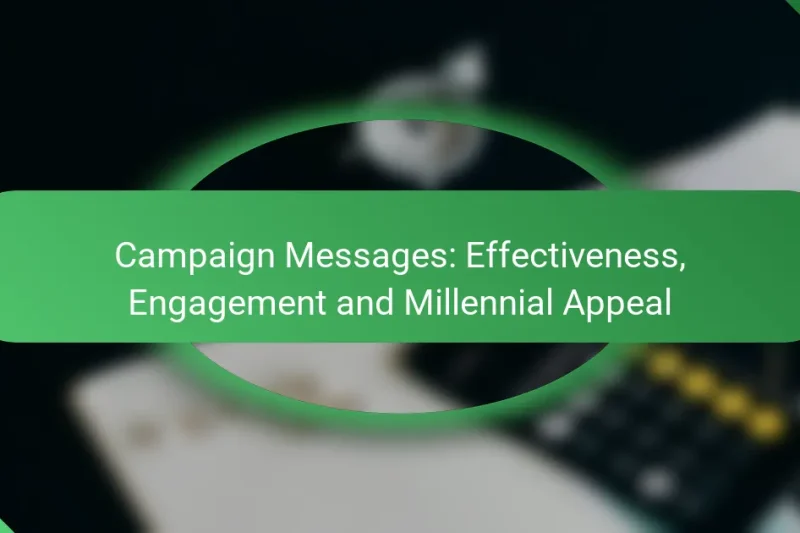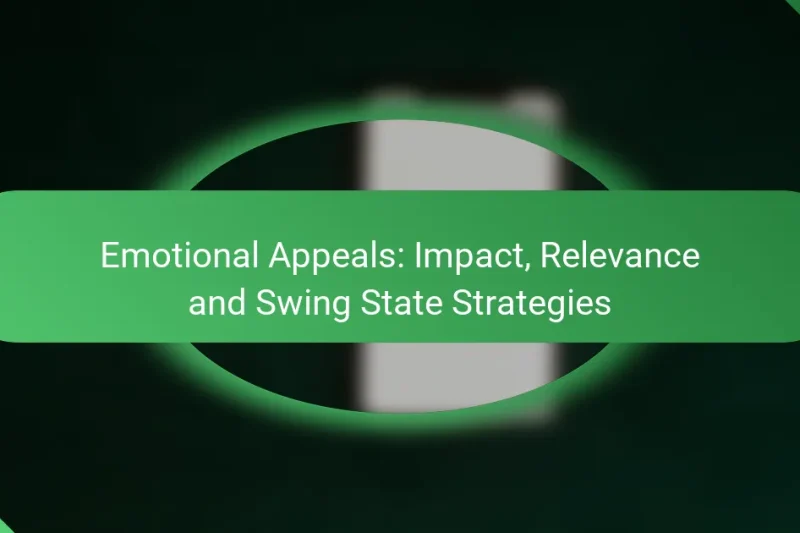Crafting effective campaign messages for millennials requires a deep understanding of their values and communication styles, … Campaign Messages: Effectiveness, Engagement and Millennial AppealRead more
Political Campaign Messaging
Effective political campaign messaging is crucial for connecting with voters and addressing their values and concerns. By strategically crafting a core message, establishing a strong brand identity, and incorporating a compelling call to action, campaigns can create a persuasive narrative that resonates with their audience. Additionally, measuring the impact of these messages through polls and social media engagement helps refine strategies and enhance voter outreach.
Messaging Impact: Voter Turnout, Recent Elections and Analysis
Messaging plays a crucial role in influencing voter turnout in the United States, as it shapes … Messaging Impact: Voter Turnout, Recent Elections and AnalysisRead more
Messaging in High-Competition Environments: Strategies, Challenges and Success
In high-competition environments, effective messaging is crucial for businesses seeking to differentiate themselves and connect with … Messaging in High-Competition Environments: Strategies, Challenges and SuccessRead more
Data Analytics: Tailoring Messages, Targeting Demographics and Engagement
Data analytics plays a crucial role in crafting tailored messages for specific demographics by examining consumer … Data Analytics: Tailoring Messages, Targeting Demographics and EngagementRead more
Inclusive Campaign Messages: Diversity, Community Engagement and Representation
Inclusive campaign messages play a crucial role in enhancing community engagement by promoting a sense of … Inclusive Campaign Messages: Diversity, Community Engagement and RepresentationRead more
Emotional Appeals: Impact, Relevance and Swing State Strategies
Emotional appeals play a crucial role in shaping voter behavior, particularly in swing states where every … Emotional Appeals: Impact, Relevance and Swing State StrategiesRead more
Local vs National Campaigns: Which Messaging Strategy Works Best
When it comes to campaigning, the choice between local and national strategies hinges on the target … Local vs National Campaigns: Which Messaging Strategy Works BestRead more
How to create effective political campaign messaging in the US?
Creating effective political campaign messaging in the US involves understanding your audience and delivering clear, impactful messages that resonate with their values and concerns. This requires a strategic approach that combines demographic insights, emotional connections, and local relevance.
Identify target demographics
Understanding your target demographics is crucial for tailoring your campaign messaging. This involves analyzing factors such as age, gender, income level, education, and geographic location to identify key voter segments.
Utilize surveys and focus groups to gather insights about the preferences and concerns of these demographics. For example, younger voters may prioritize climate change, while older voters might focus on healthcare issues.
Craft clear and concise messages
Your campaign messages should be straightforward and easy to understand. Avoid jargon and complex language; instead, use simple terms that convey your key points effectively.
Consider using slogans or taglines that encapsulate your message in a memorable way. A good rule of thumb is to keep messages under 10 words to ensure they are easily retained by voters.
Utilize emotional appeals
Emotional appeals can significantly enhance the effectiveness of your campaign messaging. By connecting with voters on an emotional level, you can create a sense of urgency and importance around your campaign.
Use storytelling to illustrate your points, sharing personal anecdotes or testimonials that resonate with your audience’s experiences and values. This approach can foster a deeper connection and encourage voter engagement.
Incorporate local issues
Addressing local issues in your campaign messaging is essential for building trust and relevance with voters. Identify the key concerns specific to your community, such as education, public safety, or infrastructure.
Highlight your stance on these issues and propose actionable solutions. This shows voters that you understand their needs and are committed to addressing them, which can significantly enhance your campaign’s credibility.
Leverage social media platforms
Social media platforms are vital tools for disseminating your campaign messaging effectively. Utilize platforms like Facebook, Twitter, and Instagram to reach a broader audience and engage with voters directly.
Tailor your content for each platform, using visuals and interactive elements to capture attention. Regular updates and responses to voter inquiries can foster a sense of community and keep your campaign relevant in the fast-paced digital landscape.
What are the key components of political campaign messaging?
The key components of political campaign messaging include the core message, brand identity, and call to action. These elements work together to create a cohesive and persuasive narrative that resonates with voters.
Core message
The core message is the central idea or theme that a campaign communicates to its audience. It should be clear, concise, and memorable, encapsulating the candidate’s values and vision. For example, a campaign might focus on themes like “economic growth” or “social justice” to connect with specific voter concerns.
When crafting a core message, consider the target audience’s priorities and emotions. It should be relatable and address the issues that matter most to voters, ensuring it stands out in a crowded political landscape.
Brand identity
Brand identity encompasses the visual and verbal elements that represent a campaign, including logos, colors, and slogans. A strong brand identity helps create recognition and trust among voters. For instance, using consistent imagery and messaging across all platforms reinforces the campaign’s values and mission.
To build an effective brand identity, ensure that it aligns with the core message and resonates with the target demographic. This includes tailoring the tone and style of communication to reflect the candidate’s personality and appeal to voters’ aspirations.
Call to action
The call to action (CTA) is a crucial component that encourages voters to engage with the campaign, whether through donations, volunteering, or voting. A clear and compelling CTA can significantly impact voter participation. For example, phrases like “Join us in making a difference” or “Vote for change” can motivate action.
When designing a CTA, make it specific and actionable. Use urgency and clarity to guide voters on what steps to take next, ensuring that the message is easy to understand and follow. Avoid vague language that may confuse or deter potential supporters.
How to measure the effectiveness of campaign messaging?
Measuring the effectiveness of campaign messaging involves analyzing various data sources to understand how well the message resonates with the target audience. Key methods include polls, focus groups, and social media engagement metrics, each providing unique insights into voter perceptions and behaviors.
Polls and surveys
Polls and surveys are essential tools for gauging public opinion on campaign messaging. They can reveal how well a message is understood and its impact on voter preferences. Regularly conducting polls throughout the campaign can help identify trends and shifts in voter sentiment.
When designing polls, consider using a mix of quantitative questions (e.g., rating a message on a scale) and qualitative questions (e.g., open-ended responses). This combination provides a more comprehensive view of voter reactions. Aim for a sample size that reflects the demographics of your target audience to ensure accurate results.
Focus groups
Focus groups offer in-depth insights into how voters perceive campaign messaging. By gathering a small, diverse group of individuals, campaigns can explore emotional responses and the nuances of message interpretation. This qualitative method allows for a deeper understanding of voter motivations and concerns.
To conduct effective focus groups, select participants that represent key voter segments and prepare open-ended questions that encourage discussion. Analyze the feedback for common themes and adjust messaging accordingly. Be aware that focus groups can be influenced by group dynamics, so consider using multiple groups for balanced insights.
Social media engagement metrics
Social media engagement metrics provide real-time feedback on how campaign messaging is resonating with the public. Metrics such as likes, shares, comments, and follower growth can indicate the effectiveness of specific messages or content types. High engagement often correlates with strong voter interest and support.
To effectively use social media metrics, track engagement over time and compare different messages to identify what resonates best. Consider using tools that analyze sentiment in comments to gauge emotional reactions. Be cautious of relying solely on numbers; qualitative insights from comments can provide context to the data.
What are common pitfalls in political campaign messaging?
Common pitfalls in political campaign messaging include overcomplicating messages, ignoring audience feedback, and neglecting digital platforms. These mistakes can dilute a campaign’s effectiveness and hinder voter engagement.
Overcomplicating messages
Overcomplicating messages can confuse voters and detract from the core message. Campaigns should aim for clarity and simplicity, focusing on key themes that resonate with the electorate.
For example, using jargon or complex language may alienate potential supporters. Instead, aim for straightforward language that communicates the campaign’s values and goals effectively.
Ignoring audience feedback
Ignoring audience feedback can lead to a disconnect between the campaign and its supporters. Engaging with voters through surveys, social media, and town hall meetings can provide valuable insights into their concerns and preferences.
Campaigns should actively listen and adapt their messaging based on this feedback. For instance, if voters express a strong interest in healthcare, the campaign should prioritize that topic in its communications.
Neglecting digital platforms
Neglecting digital platforms can limit a campaign’s reach and engagement. In today’s political landscape, a strong online presence is crucial for connecting with voters, especially younger demographics who primarily consume information digitally.
Campaigns should utilize social media, email newsletters, and targeted online ads to disseminate their messages. Regularly updating content and engaging with followers can enhance visibility and foster a sense of community among supporters.
What frameworks can guide political messaging strategies?
Effective political messaging strategies can be guided by various frameworks that help shape and refine communication. These frameworks assist in identifying strengths, weaknesses, opportunities, and threats, as well as testing messages to ensure they resonate with the target audience.
SWOT analysis
SWOT analysis is a strategic planning tool that evaluates the strengths, weaknesses, opportunities, and threats related to a political campaign. Strengths might include a strong candidate image or robust funding, while weaknesses could involve limited outreach or negative public perception.
Opportunities may arise from current events or demographic shifts, and threats could include competitive candidates or changing voter sentiments. Conducting a SWOT analysis helps campaigns focus on leveraging their strengths and addressing weaknesses while navigating external factors effectively.
Message testing frameworks
Message testing frameworks involve systematic approaches to evaluate how well campaign messages resonate with voters. Techniques such as focus groups, surveys, and A/B testing allow campaigns to gauge reactions and refine their messaging accordingly.
For instance, a campaign might test different slogans or key issues to see which generates more positive responses. This iterative process helps ensure that the final messaging aligns with voter values and preferences, ultimately enhancing the campaign’s effectiveness.






